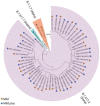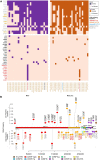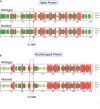Clinico-Genomic Analysis Reiterates Mild Symptoms Post-vaccination Breakthrough: Should We Focus on Low-Frequency Mutations?
- PMID: 35308382
- PMCID: PMC8927057
- DOI: 10.3389/fmicb.2022.763169
Clinico-Genomic Analysis Reiterates Mild Symptoms Post-vaccination Breakthrough: Should We Focus on Low-Frequency Mutations?
Abstract
Vaccine development against severe acute respiratory syndrome coronavirus 2 (SARS-CoV-2) has been of primary importance to contain the ongoing global pandemic. However, studies have demonstrated that vaccine effectiveness is reduced and the immune response is evaded by variants of concern (VOCs), which include Alpha, Beta, Delta, and, the most recent, Omicron. Subsequently, several vaccine breakthrough (VBT) infections have been reported among healthcare workers (HCWs) due to their prolonged exposure to viruses at healthcare facilities. We conducted a clinico-genomic study of ChAdOx1 (Covishield) VBT cases in HCWs after complete vaccination. Based on the clinical data analysis, most of the cases were categorized as mild, with minimal healthcare support requirements. These patients were divided into two sub-phenotypes based on symptoms: mild and mild plus. Statistical analysis showed a significant correlation of specific clinical parameters with VBT sub-phenotypes. Viral genomic sequence analysis of VBT cases revealed a spectrum of high- and low-frequency mutations. More in-depth analysis revealed the presence of low-frequency mutations within the functionally important regions of SARS-CoV-2 genomes. Emphasizing the potential benefits of surveillance, low-frequency mutations, D144H in the N gene and D138Y in the S gene, were observed to potentially alter the protein secondary structure with possible influence on viral characteristics. Substantiated by the literature, our study highlights the importance of integrative analysis of pathogen genomic and clinical data to offer insights into low-frequency mutations that could be a modulator of VBT infections.
Keywords: COVID-19; clinico-genomic; disease severity; integrative analysis; low-frequency mutations; vaccination breakthrough.
Copyright © 2022 Kanakan, Mehta, Devi, Saifi, Swaminathan, Maurya, Chattopadhyay, Tarai, Das, Jha, Budhiraja and Pandey.
Conflict of interest statement
The authors declare that the research was conducted in the absence of any commercial or financial relationships that could be construed as a potential conflict of interest.
Figures




Similar articles
-
Vaccine Breakthrough Infections by SARS-CoV-2 Variants after ChAdOx1 nCoV-19 Vaccination in Healthcare Workers.Vaccines (Basel). 2021 Dec 31;10(1):54. doi: 10.3390/vaccines10010054. Vaccines (Basel). 2021. PMID: 35062715 Free PMC article.
-
Clinico-Genomic Analysis Reveals Mutations Associated with COVID-19 Disease Severity: Possible Modulation by RNA Structure.Pathogens. 2021 Aug 31;10(9):1109. doi: 10.3390/pathogens10091109. Pathogens. 2021. PMID: 34578142 Free PMC article.
-
Learning From Biological and Computational Machines: Importance of SARS-CoV-2 Genomic Surveillance, Mutations and Risk Stratification.Front Cell Infect Microbiol. 2021 Dec 24;11:783961. doi: 10.3389/fcimb.2021.783961. eCollection 2021. Front Cell Infect Microbiol. 2021. PMID: 35047415 Free PMC article.
-
Review of COVID-19 Variants and COVID-19 Vaccine Efficacy: What the Clinician Should Know?J Clin Med Res. 2021 Jun;13(6):317-325. doi: 10.14740/jocmr4518. Epub 2021 Jun 25. J Clin Med Res. 2021. PMID: 34267839 Free PMC article. Review.
-
Omicron variant (B.1.1.529) of SARS-CoV-2: Mutation, infectivity, transmission, and vaccine resistance.World J Clin Cases. 2022 Jan 7;10(1):1-11. doi: 10.12998/wjcc.v10.i1.1. World J Clin Cases. 2022. PMID: 35071500 Free PMC article. Review.
Cited by
-
Mutational dynamics across VOCs in International travellers and Community transmission underscores importance of Spike-ACE2 interaction.Microbiol Res. 2022 Sep;262:127099. doi: 10.1016/j.micres.2022.127099. Epub 2022 Jun 25. Microbiol Res. 2022. PMID: 35779308 Free PMC article.
-
Transcriptionally active nasopharyngeal commensals and opportunistic microbial dynamics define mild symptoms in the COVID 19 vaccination breakthroughs.PLoS Pathog. 2023 Feb 17;19(2):e1011160. doi: 10.1371/journal.ppat.1011160. eCollection 2023 Feb. PLoS Pathog. 2023. PMID: 36800345 Free PMC article.
-
Clinico-genomic study reveals association of dengue virus genome high frequency mutations with dengue disease severity.Sci Rep. 2025 May 28;15(1):18724. doi: 10.1038/s41598-025-00462-z. Sci Rep. 2025. PMID: 40436903 Free PMC article.
References
-
- ARTIC (2021). ARTIC-nCoV-bioinformaticsSOP-v1.1.0. Available online at: https://artic.network/ncov-2019/ncov2019-bioinformatics-sop.html (accessed on December 3, 2021).
-
- Ashok Kumar T. (2013). CFSSP: Chou and Fasman secondary structure prediction server. Res. J. 1 15–19. 10.5281/zenodo.50733 - DOI
-
- Babraham Bioinformatics (2021a). FastQC A Quality Control Tool for High Throughput Sequence Data. Available online at: https://www.bioinformatics.babraham.ac.uk/projects/fastqc/ (accessed on August 23, 2021).
-
- Babraham Bioinformatics (2021b). Trim Galore!. Available online at: https://www.bioinformatics.babraham.ac.uk/projects/trim_galore/ (accessed on August 23, 2021).
LinkOut - more resources
Full Text Sources
Miscellaneous

